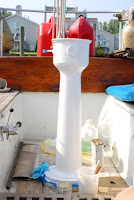
The ice box on the our boat, which is essentially the same as that on the Cheoy Lee Clipper 36's, was no longer insulating very well and was a real pain to access and use on a regular basis. We figure that an occasional cruise or weekend trip on the boat would be fine and the crew could make due with it, but it was very deep, and one pretty much falls into it head first when reaching for anything.

For living aboard though, we needed a refridgeration system that could maintain cool temperatures and be more accessable. We also didn't need such a huge volume of space devoated to cooling. Two 5lb bags of ice last about 2 days in 80 degree weather and still only got the ice box down to 60 degrees. So the it had to go. In the meantime we picked up a small dorm style fridge serves our space and cooling needs.
We took saw, hammer, grinder and crowbar to the ice box and after about 5 hours of work and 15 trash bags full (trash bag fulls?) of insulation and debris finally stripped the ice box down to the hull. We have been drawing up ideas on how to rebuild the space in such a way that we can access it all easily. The wet locker space, which is behind the ice box and under the forward end of the starboard cockpit seat is very difficult to access and we're hoping to incorporate it into the new cabinetry plans.
As you can see, the fiberglass is almost 3/4" inch thick in some places. We went through alot of discs and blades to get it all out. The insulation was glued to the hull and bulkheads and required alot of hacking and digging (and lots of styrofoam squeaking!) to get it all cleaned out.
Next we'll clean the area really good, and make any glass repairs before adding cleats and stringers to build the new cabinets onto.

































